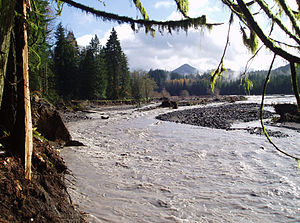Nisqually River
| Nisqually River | |
| River | |
|
Nisqually River near Ashford during a flood in 2006 that destroyed a campground in Mount Rainier National Park.
|
|
| Country | United States |
|---|---|
| State | Washington |
| Districts | Nisqually Indian Reservation, Fort Lewis |
| Tributaries | |
| - left | Little Nisqually River |
| - right | Mashel River |
| Source | Nisqually Glacier |
| - location | Mount Rainier |
| - elevation | 4,809 ft (1,466 m) |
| - coordinates | 46°47′39″N 121°44′54″W / 46.79417°N 121.74833°W |
| Mouth | Puget Sound |
| - location | Nisqually National Wildlife Refuge |
| - elevation | 0 ft (0 m) |
| - coordinates | 47°6′31″N 122°42′11″W / 47.10861°N 122.70306°WCoordinates: 47°6′31″N 122°42′11″W / 47.10861°N 122.70306°W |
| Length | 81 mi (130 km) |
| Basin | 517 sq mi (1,339 km2) |
| Discharge | for La Grande, WA |
| - average | 1,460 cu ft/s (41 m3/s) |
| - max | 39,500 cu ft/s (1,119 m3/s) |
| - min | 460 cu ft/s (13 m3/s) |
The Nisqually River /nɪˈskwɑːli/ is a river in west central Washington in the United States, approximately 81 miles (130 km) long. It drains part of the Cascade Range southeast of Tacoma, including the southern slope of Mount Rainier, and empties into the southern end of Puget Sound. Its outlet was designated in 1971 as the Nisqually Delta National Natural Landmark.
The Nisqually River forms the Pierce-Lewis county line, as well as the boundary between Pierce and Thurston counties.
The river rises in southern Mount Rainier National Park, fed by the Nisqually Glacier on the southern side of Mt. Rainier. It flows west through Ashford and Elbe along Route 706. It is then impounded for hydroelectricity by the Alder Dam, completed in 1944, and the LaGrande Dam, completed in 1912 and rebuilt in 1945. They hold back Alder Reservoir and the inaccessible two-mile long LaGrande Reservoir. Before the construction of the dams, a natural fish barrier prevented anadromous fish from ascending the Nisqually above what is now La Grande Reservoir.
...
Wikipedia


